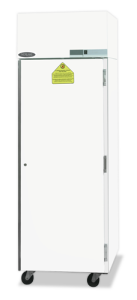When to Specify a Flammable Refrigerator

Google refrigerator explosions and chances are you’ll get a lot of hits because of news articles reporting on refrigerator explosions. These events can be spectacular, dangerous and costly. They occur when flammable products are stored in conventional refrigeration units and fumes are ignited by refrigerator electronics such as thermostats, compressors, timers and light switches. A refrigerator for flammable storage is designed to prevent these occurrences. Designs differ from more costly explosion proof refrigerators designed to eliminate the danger of igniting volatile vapors in the laboratory environment.
We agree it is a subtle but important difference. Confusion can occur because most reported refrigerator explosions result when the contents or vapors explode due to an internal ignition source.
Flammable Storage Refrigerator Safety Standards
We’ll start by stating that workarounds do not work when it comes to satisfying NFPA and OSHA guidelines regarding storing volatile products in a refrigeration system. In other words sealed or unbreakable containers do not make storage in conventional refrigerators safe.
Instead, store flammables in approved containers inside units conforming to Class I Division 2 storage per NFPA standards 70, 99, 45 and 479 A as well as UL standard 471. An example of confirming equipment is the 24 cubic foot NSFR 241 Norlake flammable refrigerator offered by Tovatech. This model features manual defrost, has a mechanical thermostat and no accessories in the cabinet that could cause a spark.
Flammable refrigerators and freezers should be clearly labeled as such on the door. If facilities also have general purpose refrigerators clear procedures should be in place to differentiate the units. For example the most basic precaution is to clearly label general purpose units as “Not for Storage of Volatile Products.”
Contact the scientists at Tovatech for more information on specifying flammable and explosion proof refrigerators and/or freezers to comply with critical safety standards in the research lab. Potential personnel injury, death and severe physical damage to the facility when using substandard units is not worth the “cost savings” of modified residential refrigerators and freezers.
